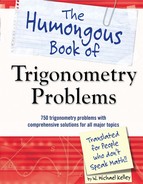In Chapter 15, you explore vector addition, which combines two vectors to produce another vector. Mathematically speaking, this means that the vectors are considered “closed” under addition. Simply stated, a set (like vectors) is closed under an operation when performing an operation (like addition) on that set produces another member of that set.
This is not an entirely new concept. The set of integers is closed under addition, subtraction, and multiplication—if you add, subtract, or multiply two integers, the result is another integer. Note that integers are not closed over division, because dividing two integers can produce a fraction: The operations 1 ÷ 2 and 3 ÷ 5 produce fractions, not integers.
In this chapter, you explore the dot product, an operation under which the set of vectors is not closed. The dot product of two vectors is not a vector; it is a real number.
You spend the first half of the chapter getting familiar with the dot product, answering questions like “How do I calculate it?”, “Is it commutative?”, “Is it distributive?”, “Does it prefer dogs or cats as pets?”…that sort of thing.
By the end of the chapter, you’ll be using the dot product to calculate the angle between vectors, to identify orthogonal (perpendicular) vectors, to create vector projections (and actually understand what that means), and to apply all of this in a real life situation. That’s a non-threatening way of saying “word problems,” but don’t panic.
